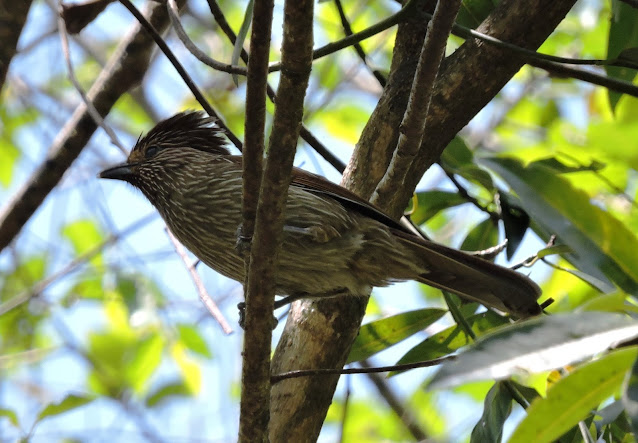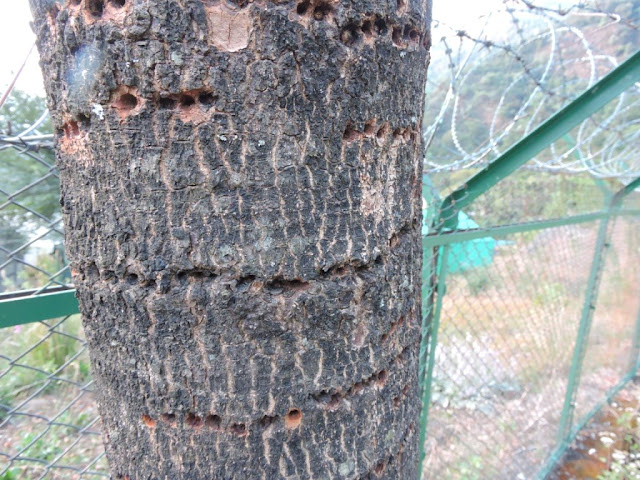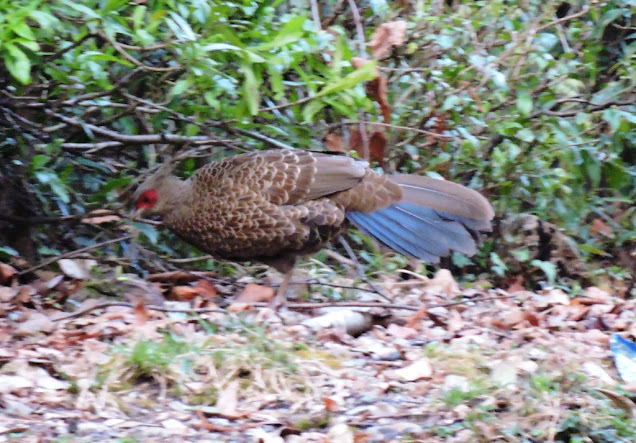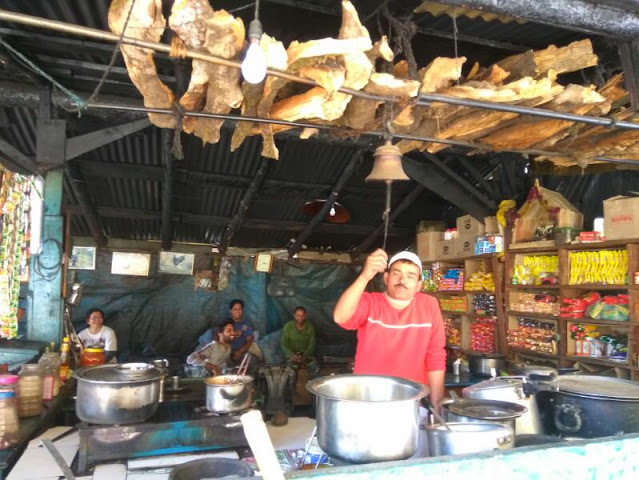09
to 14 April 2017
 |
The Garhwal Himalayas |
Each
one of us is actually different persons existing in one body. What we appear to
be, is the personality that is most convenient for our day to day existence. Most
of us quietly harbour the other selves, while going through the everyday
humdrum existence.
But
every now and then we get an opportunity to step into the other self. It is rejuvenating,
rather cathartic almost, to forget what we are in real life and enter a
parallel universe. One where we are not doctors, engineers, accountants,
housewives or salesmen with targets, but rather only spectators before whom the
drama of Nature unfolds.
One such drama unfolded this April when we embarked upon a birding trip to
Chopta-Tungnath in the Garhwal Himalayas.
We
landed at Dehradun railway station on a crisp morning and realized immediately
how fortunate we were. Apparently the previous week was attended by the
most vicious rain and hailstorms.
Even
as we waited for the vehicles to arrive we found a tree hole into which a female
Indian grey horn-bill had disappeared. Now it was the job of the male to stand
guard and after the chicks were hatched, to keep bringing insects for feeding
the young ones. Even this strict fruitarian/vegetarian bird had realized that
one needs high class protein during the growth phase.
 |
Shivpuri - the rafting capital of India |
 |
White waer rafting in the river Ganga |
The
road started winding up after Rishikesh as we passed the numerous whitewater
rafting camps near Shivpuri. Though they tended to cause minor jams on the
road, it was quite heartening to see that youngsters were indulging in outdoor
sport/adventure activities.
The
road was in a surprisingly pristine condition considering we were in the hills. But the flip side was that the drivers tended to think that it was a plains
highway and were driving accordingly!!
Areas
of landslides were many, but the government repair machinery was in ample evidence
everywhere. Maybe the small state of Uttarakhand had realized that it was all
about tourism and those roads were the most important ingredient for a
successful tourist experience. Also
the famous Yatras were to start next month and lacs of people were expected
shortly..
 |
Sangam at Rudraprayag |
We
stopped for a photo - op of the Sangam area just past Rudraprayag where the
rivers Mandakini and Alaknanda meet. One could clearly see the two streams with
their different hue of the water based on terrain and precipitation in the catchment
areas but still maintaining their unique character for quite a distance even
after they joined. Somehow it reminded one of a marriage. Two different people, different backgrounds,
different experiences, joining and maintaining their individual hue for some of
the way and then imperceptibly merging into one another…
 |
Sadhu on foot carrying his world with him |
By
midday the Sun was a scorching as we sped up the yatra route to Badrinath and Kedarnath,
though we were on a different kind of yatra.
We
did come across a number of hermits (Sadhus) who did not seem to be affected by
the elements, however, and chose to walk up with all their worldly possessions.
No amount of analysis could explain why a human being would indulge in this
kind of lifestyle on a permanent basis (I am not referring to the thousands of
people who turn Yatris for a month in August in different parts of the
country). These sadhus have seemingly renounced the ‘normal’ existence and have
transcended to a level beyond what is visible to us. No wonder some foreigners
also camp here in search of the elusive...
Breakfast
was at the Bhagirathi Lodge which afforded fresh tree pickings of ripe
mulberries.
After
crossing Chamoli Gopeshwar, we were now headed towards Mandal along a narrow
but well maintained mountain road.
 |
The Lodge at Mandal |
We
drove in to the Gurukrupa Lodge at Mandal by 6 pm but there was still enough
light to take in the beautiful views of the trails around the lodge.
Before
we could finish the tea and head to our rooms, a rather dramatic moonrise was
in evidence.
 |
Blue whistling thrush |
Next morning, none
of us really needed a wake up call as the resident blue whistling thrush did
the needful from behind our windows.
The
morning trail was on a quaint village path behind the lodge and we were
immediately rewarded with sightings of the grey backed woodpecker and the
russet sparrow. The redbilled blue magpies were all around. The paper wasps had
built huge nests hanging from rocky outcrops resembling the texture of hand
made paper.
 |
Grey backed woodpecker |
The
area around the bridge on the stream was quite fruitful with the white capped
and plumbeous water redstarts giving good views. The brown dipper also obliged
very soon. It clearly displayed its diving behaviour designed to get insects at
a level deeper to those picked by the redstarts. Apparently its wings are also
specially wax coated for this purpose.
 |
Paper wasp nest |
In
the distance we could witness the Himalayan Tahrs doing their impossible
looking jumps on the sheer vertical rock face. It seems they can’t live
elsewhere like normal deer because they are not designed for fast running.
The
village primary school was in assembly. Having listenend to so many news
reports about schools without buildings and teachers, it was heartening to see boys and girls benefiting
from formal education in this rather remote
area. In fact it is thanks to this basic formal education that our guide
Harish managed to land a job as a research assistant to a professor from
Cornell University who was doing research on birds in this area.
The
mystery of the haystacks hanging from trees was soon solved when we were
informed that it is a simple expedient to prevent the hay, meant as cattle
feed, from rotting due to the rain.
 |
Wheat fields |
Cultivation
is primarily of the wheat crop and not rice as one would normally associate
with the step farms in the hills.
 |
Common rosefinch |
 |
Turtle dove |
Common
rosefinches, Himalayan bulbuls, turtle doves were also seen.
 |
Streaked laughingthrush |
The
streaked laughingthrush seemed to be the commonest bird in the village and
quite willing to pose even for amateur photographers without long lenses.
In the post breakfast session we went on the other side of the stream and had good sightings of the grey treepies who were attracted to the ripe mulberries. The great barbet was lazily perched among the fruit laden tree. No wonder that it had the energy to keep calling incessantly all day long. The striated laughingthrush also made a brief appearance.
In the post breakfast session we went on the other side of the stream and had good sightings of the grey treepies who were attracted to the ripe mulberries. The great barbet was lazily perched among the fruit laden tree. No wonder that it had the energy to keep calling incessantly all day long. The striated laughingthrush also made a brief appearance.
We had been told specifically to stay away from the stinging nettle, but I managed get stung nevertheless in my enthusiasm for a better shot.
The
afternoon trail was very fruitful going along the Chopta route upto Kanchula
Khark. We got spectacular views of one of the smallest birds in India-the
firebreasted flowerpecker. Several mixed
hunting parties were spotted consisting of spot winged tits, green backed tits,
black throated tits, white tailed nuthatches
 |
Great barbet |
 |
Grey treepie |
 |
Striated laughingthrush |
 |
Firebreasted flowerpecker |
 |
Rock bunting |
 |
Himalayan Langur |
By
the time we reached the forest rest house at Kanchula Khark it was late
afternoon and the maple leaves after which the area is named gave a majestic
colour to the forest.
The
mistle thrush was spotted foraging in the leaf litter and so was the grey
winged blackbird. The rufous bellied woodpecker, better remembered as the
tomato headed woodpecker was quite a spectacle. It is a sap sucking woodpecker
and is responsible for some very neat woodcarvings seen in nature.
The rufous bellied niltava gave a good sighting towards the evening.
The rufous bellied niltava gave a good sighting towards the evening.
 |
| Neat wood carvings by rufous bellied woodpecker |
 |
Rufous bellied woodpecker |
 |
Himalayan woodpecker |
 |
Grey winged blackbird |
 |
Rufous bellied niltava |
 |
Black throated tit |
 |
Koklass phesant female |
Harish
was looking especially sad and said that today we had 0% chance of seeing the Koklass
pair which is found in this area as there was roadrepair work going on. No
sooner had he finished this sentence he suddenly exclaimed that he had spotted
a Koklass pheasant, and all hell broke loose. We finally managed to get some
shots of the male and later the perfectly camouflaged female as well.
On
the way back as the light was fading, we spotted several pairs of Khalij
pheasants disappearing into the bushes along the roads. Some males were even
spotted giving majestic displays to apparently unimpressed females.
 |
Khalij phesant |
Next day we
woke up to a cool and crisp morning and took the path along the botanical
research station. The calls of the Himalayan bulbuls were bringing the whole
valley to life. The sun - bathed view of the blue capped rock thrush made the
photographers go crazy.
 |
| Botanical station |
 |
| Trail down to the bridge |
 |
Blue Capped rock thrush |
 |
Spot winged grosbeak |
This trial led to a bridge where the highlight was the
spotwinged grosbeak. So named due to its gross sized beak resembling a parrots
bill. As it sat inside a leafy tree, lazily stuffing itself with fruits, a
clear view was difficult to get. Later we were rewarded with the sighting of a
black francolin in flight in the area past the bridge.
The
climb upto Chopta threw up good sightings of the green tailed sunbird, white
throated laughingthrush and the oriental white eye.
We
had a forced stop at the Monal point valley due to road work. We found several
French dudes had decided to do the yatra on Enfield bullets !!
We reached our destination, the Green Valley resort, about 3 km short of Chopta, by lunchtime.
The
afternoon birding was a little dull to start with but we got good sightings of
the bartailed treecreeper and the resident woodpeckers. The Himalayan Griffon was
spotted at its favourite perch before we reached the meadows where outdoor
camps had been set up.
 |
| Himalayan griffon |
 |
| The meadow camps off Chopta |
Just
as we were enjoying close views of the ultramarine flycatcher, the collared
owlet was suddenly spotted in the rhododendron tree. The owlet was mobbed by
all manner of small birds like grey headed canary flycatchers, ashy throated
warblers, buff barred warblers, black lored tits, yellow browed tits and green
backed tits.
It
was on the way back that we got the first sighting of a pair of Monal pheasants
a short distance from our camp. We were assured that this was only a trailer
and that more was to follow later. Nevertheless the female gave some very good
views, again perfectly camouflaged but with very beautiful eyes. Bijit remarked
that even the male had the same eyes, but when it came to seeing the male, who
was seeing the eyes. The entire apparition is so ridiculously colourful…
We
had to set out very early next morning so as to reach Tungnath by daybreak.
Luckily our ponies arrived right on time and we were able to start the climb by
0545. All
the briefing about how cold and stiff we will be by the time we reached the top
did not turn out to be an exaggeration. There
was one pit stop with a welcome cup of tea for us while the ponies were seen
enjoying Parle G biscuits!!
The
decision to avail a pony ride to the top and trek back seemed very sensible
when we saw the sheer gradient of the climb. After all we had to do 3000 feet
over just about 2 Km.
 |
The tungnath trail |
Just
as we were nearing the summit and the tree line ended, there was a flurry of
activity visible. There were Monal pheasants all around happily pecking at
insects in the mud, seemingly unperturbed by all the travelers. We counted at
least 20 individuals, mostly males. The impact of seeing this outrageously
colourful bird in the wild cannot be adequately put into words. I guess that’s
why many birders/photographers come here to watch this as a single point agenda.
Though the pheasant is seen in Himachal and other areas as well, the sightings
here are nearly assured and plentiful.
Even
as we disembarked and were trying to get circulation into our hands we found
that there were alpine accentors foraging all around. My decision to go around
the corner to answer natures call cost me a very rare sighting of the red
fronted rosefinch. Just as I came back, I found Mandar with a camera (a rare
sighting these days; he has already photographed everything worthwhile already)
in a very excited state with teeth chattering and numb fingers but trying to
click away nevertheless. This turned out to be a lifer for all those who
managed a look.
 | |
| The best breakfast location in the world |
We moved towards the temple and to the plateau to the right side: the area very
aptly described as the best breakfast location in the world. We voraciously
consumed the aloo parathas which were, incredulously, still warm. This was
followed by the customary photo session.
 |
The Tungnathji temple |
I chose to climb up to the temple proper, though it opened for Darshan only on 01
May. And that turned out to be the best part. Sitting atop the peak at 11000
feet in solitude with the morning sun caressing me all over in a moment of meditation
somehow seemed to get me closer to the Creator….No wonder all the Rishis and
Munis always head for the hills.
We
decided to take the trail leading to the medicinal plant research station area.
There were a number of plain mountain finches and olive backed pipits on
display. Though at this altitude there are no trees, the first vegetation to be
encountered are the high altitude rhododendrons. Somehow due to the unusual
rains of last week, none of them had flowered as yet.
 |
White browed fulvetta |
Despite this, they
harboured a variety of birds and we got excellent sightings of the rufous
gorgeted flycatcher and the white browed
fulvetta, the only one in western Himalayas. The yellow bellied fantail made an
appearance and soon we had the Monal sightings that are the stuff of legends.
They were there in the open sunshine, foraging, in flight, perching on trees,
running….. The photographers literally went crazy this time.
As
if that was not enough, Varsha spotted something in the bush, which was
initially sought to be dismissed as the fantail. And suddenly this majestic
golden bush robin decided to plant itself on a bush in clear sunlight at four
feet distance in front of the group. And remained there for a full 3 minutes, seemingly glued to the tree. As if to underline that Chopta is not necessarily
all about the Monal only!!
 |
Golden bush robin |
The trek down the path from Tungnath was a pleasant affair, which in any case was a better option than being atop a downwardly inclined pony.
By the time we reached the base, the sun was quite bright and hot, but neither that nor the steep incline seemed to deter this group of professional cyclists who were racing up from Rishikesh!!
The
post lunch session was spent in the rhododendron forest descending from Chopta.
The incessant calls of the rufous sibias could be heard everywhere.
 |
Rhododendron forest |
It
was in this fading light that there was sudden excitement as someone spotted a
black francolin among the underbushes, or so they thought. Finally it turned
out to be the common hill partridge, mostly heard and seldom seen!
 |
Chaukhamba peaks |
The
next morning saw us going past the majestic Chaukhamba viewpoint, past Chopta
and onto the Mukkumath axis. The area has the Mukku farm which has a sheep
rearing station. This area afforded excellent views of the grey bushchat and
the Indian and Eurasian cuckoos which we savoured over field breakfast. The
Himalayan rubythroat female was also having a leisurely breakfast in the cattle
yard below, but alas the male eluded us.
 |
Grey bushchat male |
 |
Himalayan rubythroat female |
Moving
down towards Mukkumath we stopped for some sinful Samosas at the place where
the deity of Tungnath spends the summer.
As
we moved further down we saw our driver Naveen gesticulating violently. By the
time we reached, it was revealed that the fortunate few in the lead vehicle had
seen the black francolin at a few feet distance from the road. Further search
for the bird remained unfruitful. The mood dipped further when we heard blaring
speakers heralding a marriage ceremony taking place in the village causing us
to believe that our feathered friends would stay far away from the festivities.
But
it seems they are made of sterner stuff and amidst all that cacophony we had
good sightings of the spot winged grosbeak and the rusty cheeked scimitar
babbler.
 |
Black faced warbler |
On
the way back we had good inflight views of the golden eagle, oriental honey
buzzard and the lamargier. A wake of griffon vultures (yes ‘wake’ is the
collective noun for a group of vultures feeding) was spotted at a stream
nearby. There were excellent views of Mrs Goulds sunbird. The day ended with
another spotting of a mixed hunting party led by the black faced warblers and a
leisurely sighting of the rufous bellied niltava.
As
is usual in birding trips, evenings are the time for reviewing the days
activities. We also heard the fascinating story of how Harish came to be a bird
guide. Naveen, our boisterous driver tried to regale us with his rustic
anecdotes while his quiet brother Nitin looked on indulgently.
 |
The Harish story by the fireplace |
The
last days sessions were again along the Ukhimath axis and were quite rewarding
in areas were the deeper red rhododendrons were flowering. Their colour becomes
fainter as the altitude increases!! We could not however get another date with
the firecapped tit which had been sighted by a few people on the previous day.
We
came down to Mandal by late evening and enjoyed a very welcome hot bath. The
next day was devoted entirely to reaching Dehradun airport which could take
anything between 6 to 10 hours depending on the traffic jams. Luckily we
reached well in time with some people branching out to spend an extra day in
Rishikesh.
As
I boarded my aeroplane to Delhi I must have dozed off because suddenly I seemed
to hear the continuous call of the Great Barbet….
 |
The Group |
Tour
organizers: Nature India
Camera:
Nikon P 600.
Additional photos courtesy Mr Bijit (Samsung mobile)
Travelers tips:
1.
Travel time from T3 terminal of
Delhi airport to New Delhi Railway station (Ajmeri gate side) is 19 minutes by
Metro @Rs 60 only. Last train is at 11 pm. Frequency is 15 min.
 |
Airport Metro |
2. We were informed that the facilities of the
executive lounge in the NDLS are excellent and reasonable. Buffet is also available apart from rest and wash.
3. There is no first class waiting room at
Dehradun station, though MCO gets activated at 0630
4. Rooms at the Gurukrupa Lodge at Mandal at
3500 feet are basic but clean. Electric geyser is installed and more
importantly uninterrupted power supply is available. Water is of course in
plenty.
5. Rooms at Green Valley resort Chopta at
8000 feet are even better. No geyser though. Stored solar power is switched on
in the evenings and mornings.
 |
Mr Shishupal |
Mr
Shishupal and his ever smiling wife run a tight ship and even announce arrival
and departures of guests by the bell.
 |
Warmth at 11000 feet !! |
6. Road journey time is very variable even
though the roads are good. Though the heights mentioned may seem daunting,
no acclimatization of any kind is required. Very old people were seen climbing
up to Tungnath (at 11000 feet)
7. The bird sightings mentioned in the text do not do
justice to the actual birdlist of about 110 and are limited by the authors inability to photograph and remember well. For a better idea please visit http://birdingdiary.blogspot.in/2016/05/birding-in-western-himalayas-dhanolti.html
























